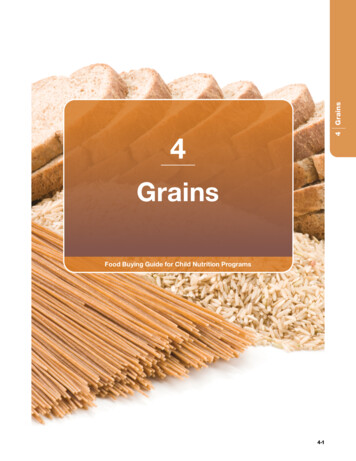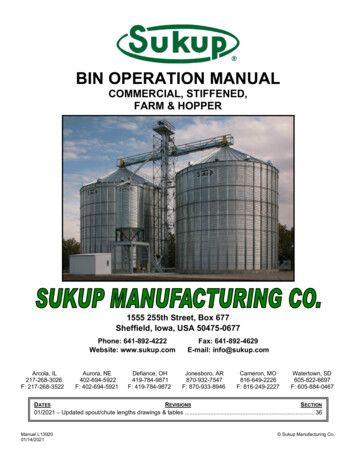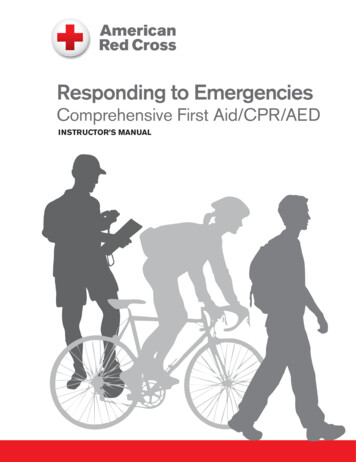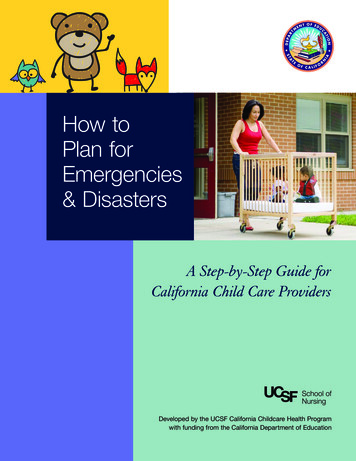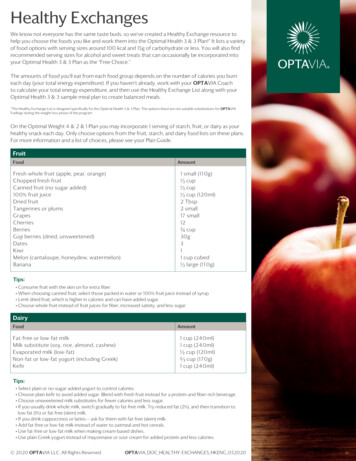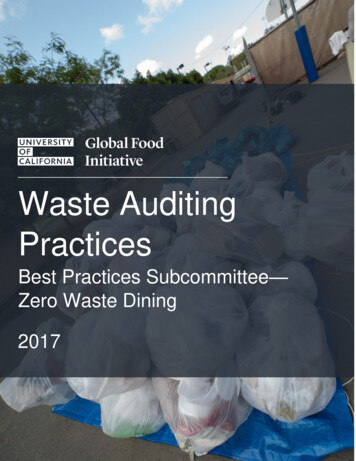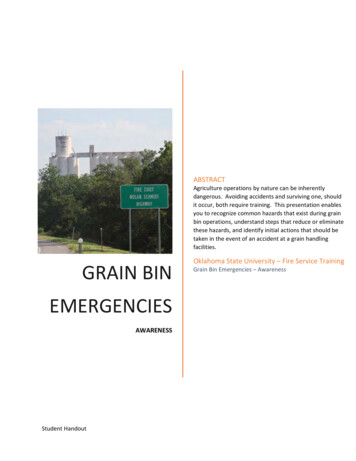
Transcription
ABSTRACTAgriculture operations by nature can be inherentlydangerous. Avoiding accidents and surviving one, shouldit occur, both require training. This presentation enablesyou to recognize common hazards that exist during grainbin operations, understand steps that reduce or eliminatethese hazards, and identify initial actions that should betaken in the event of an accident at a grain handlingfacilities.GRAIN BINEMERGENCIESAWARENESSStudent HandoutOklahoma State University – Fire Service TrainingGrain Bin Emergencies – Awareness
Student HandoutGrain Bin EmergenciesPage 1
Student HandoutSlide 1Grain Bin Emergencies AwarenessGrain BinEmergencies AwarenessOn March 23, 2009, Nolan Schmidt,volunteer fire chief for the Hydro,Oklahoma fire department diedfighting a fire inside a Hydro grain bin.Fire Chief Schmidt was one of at leastfive firefighters who climbed into a binhalf full of burning soybeans. Fellowfirefighters later cut through the sideof the metal bin to remove Schmidtand four other colleagues, who wereoverwhelmed by thick smoke.Chief Schmidt and the members of hisfire department had been dispatchedto a report of a possible fire in a largegrain bin. Firefighters entered the binto investigate. Chief Schmidt orderedfirefighters to exit the bin. In order toget out of the bin, firefighters had toclimb up a long ladder. One of thefirefighters in the bin was fatigued andcould not complete the climb. ChiefSchmidt entered the bin the assist thefirefighter. Both firefighterssubsequently lost consciousness.Firefighters on the exterior cut a holein the metal wall of the bin andextricated the two firefighters. ChiefSchmidt was transported to thehospital but was pronounced dead.The cause of death was listed asasphyxiation due to probable carbonmonoxide toxicity.Accidents occur in every occupation.When they occur in agricultureoperations or emergency responsethese accidents can be disastrous.This presentation is intended toprevent such incidents fromoccurring.Grain Bin EmergenciesPage 2
Student HandoutSlide 2INTRODUCTIONGrain Bin Emergencies AwarenessModule 1IntroductionSlide 3Grain Bin Emergencies AwarenessGOALGoalTo recognize common hazards that exist during grainbin operations, understand steps that reduce or eliminatethese hazards, and identify initial actions that should betaken in the event of an accident at a grain handlingfacilities.Audio & Video ClipfromABC’sIn An Instant“Buried Alive”Slide 4Grain Bin Emergencies AwarenessOBJECTIVESObjectives Identify the OSHA Regulations that directly affect Grain BinRescue. Identify the NFPA Standards that directly affect Grain BinRescue. List the potential hazards associated with grain bin operations. Identify avenues to mitigate the risk of injury or death fromworking around grain bin operations. Summarize what steps to take in the case of someone gettinginjured within a grain bin.Grain Bin EmergenciesPage 3
Student HandoutSlide 5ACTIVITYGrain Bin Emergencies AwarenessACTIVITY 1.1 Slide 6NameEmployerRelated ExperienceCurrent assignment and responsibilitiesFamilyHobbiesGrain Bin Emergencies AwarenessWARNING!WARNING!Agriculture operations by nature can be inherentlydangerous. The best way to avoid injuries and deathcomes from training, experience, proper use ofequipment, repeated practice, and sound judgment. It isup to you to obtain competent instruction and practicesound safety procedures.Slide 7Grain Bin Emergencies AwarenessAgriculture operations by nature can beinherently dangerous.OSHA RegulationsOSHA Regulations29 CFR 1910.272 – Grain Handling Facilities29 CFR 1910.272 App A – Grain Handling Facilities29 CFR 1910.272 App B – National ConsensusStandards29 CFR 1910.272 App C – References for FurtherInformationGrain Bin EmergenciesPage 4
Student HandoutSlide 8NFPA StandardsGrain Bin Emergencies AwarenessRescue StandardsNFPA 1670 (2009 edition) (Organization Standard) – Standardon Operations and Training for Technical Search and RescueIncidents.AwarenessOperationsTechnicianNFPA 1006 (2008 edition) (Individual Standard) – Standard forTechnical Rescuer Professional QualificationsTechnician Level ITechnician Level IISlide 9NFPA 1670Grain Bin Emergencies AwarenessNFPA 1670 Standard on Operations and Training for TechnicalSearch and Rescue Incidents (2014 Edition)– Awareness– Operations– Technician9Slide 10Grain Bin Emergencies AwarenessOther StandardsOther Standard Setting Organizations The National Institute of Occupational Safety andHealth (NIOSH) www.cdc.gov/niosh The American Society for Testing and Materials(ASTM) www.astm.org The American National Standards Institute (ANSI)www.ansi.org American Society of safety Engineers (ASSE)www.asse.orgGrain Bin EmergenciesPage 5
Student HandoutSlide 11Grain Bin Emergencies AwarenessAgricultural – Danger, Disability,DeathAgricultural – Danger, Disability, Death 60 corporate grain handling facility sites operatingin Oklahoma Oklahoma Farms 2012 Census– Number of Farms in Oklahoma 85,000– Land in Production 34,800,000 acres– Cash Receipts From Farms 7,038,174,000Slide 12Grain Bin Emergencies AwarenessGrain Bins and FacilitiesGrain Bins and Facilities BinsFlat StorageGravity WagonsGrain BuggiesHopper Bottom TrailersGrain Bin EmergenciesPage 6
Student HandoutGrain Bin EmergenciesPage 7
Student HandoutSlide 13Module 2 – Grain QualityGrain Bin Emergencies AwarenessModule 2Good Grain QualityEqualsSafety and ProfitManagement, Quality and SafetyCarol Jones, PhD.Stored Product EngineeringBiosystems and Ag. Engr. Dept.Slide 1413Module 2 GoalGrain Bin Emergencies AwarenessModule 2 GoalThe Grain Bin Emergency Awareness responder will beable to accurately identify the presence of hazardsassociated with the characteristics of poor grain quality,hazardous structures and dust collection14Slide 15The Grain Bin Emergency Awarenessresponder will be able to accuratelyidentify the presence of hazardsassociated with the characteristics ofpoor grain quality, hazardous structuresand dust collection.Module 2 ObjectivesGrain Bin Emergencies AwarenessModule 2 Objectives Identify the presence of hazards at grain bins and facilitiesList the potential hazards associated with grain bin operationsList the dangers of working around poor quality grainAnswer questions about engulfmentUnderstand what to look for on farms and at facilitiesIdentify the factors associated with dust explosionsUnderstand the method for creating a “Culture of Safety15Grain Bin EmergenciesIdentify the presence of hazards atgrain bins and facilitiesList the potential hazards associatedwith grain bin operationsList the dangers of working aroundpoor quality grainAnswer questions about engulfmentUnderstand what to look for onfarms and at facilitiesIdentify the factors associated withdust explosionsUnderstand the method for creatinga “Culture of SafetyPage 8
Student HandoutSlide 16Grain Bin Emergencies AwarenessThe FactsThe Facts Farming in the top 5 on US Bureau of Labor Standards’list of most dangerous occupations (adults and children) Estimated 300 children die each year in farmingaccidents in the USA Under 16 years old account for 20% of farm fatalities Not to mention permanent disabilities (estimated 1000each year)Slide 17Grain Bin Emergencies AwarenessAgricultural – Danger, Disability,DeathAgricultural – Danger, Disability, DeathAgriculturalProduction:Death Ratebetween 20022012Informationtaken from theCensus of FatalOccupationalinjuriesGrain Bin EmergenciesPage 9
Student HandoutSlide 18Grain Bin Emergencies AwarenessAgricultural – Danger, Disability,Death What can we do tolower these numbers? Awareness thrueducation andinteraction? FFA 4H Farm, Ranch and RuralPublicationsSlide 19Grain Bin Emergencies AwarenessAgricultural – Danger, Disability, DeathWhat can be done?Grain HandingGrain Handling 2010-11 .50 entrapments and 24 deaths This year (14-15) on target to exceed that. 77% of grain bin incident victims are unloadingbins with out-of-condition grain. Trapped in 4-5 seconds, buried in 20 seconds.Slide 20Grain Bin Emergencies AwarenessHow Does It Happen?How does it happen? Three ways it can happen; all are associated withunloading poor quality grain: Flowing Grain Collapse of a Grain Bridge Avalanche of a Vertical Grain Wall Grain Bin or Gravity Wagon Trapped in 4-5 sec, buried in 20 sec!!!Grain Bin EmergenciesPage 10
Student HandoutSlide 21Flowing GrainGrain Bin Emergencies AwarenessFlowing Grain2 – 3 secondsfor engulfmentWhy is thisworker in thebin?Slide 22Collapse OF Grain BridgeGrain Bin Emergencies AwarenessCollapse of grain bridgeOut of ConditionGrainVictim may travel 5‘ ormoreSlide 23Avalanche of grain wallGrain Bin Emergencies AwarenessAvalanche of grain wallVibration!!!Out ofconditiongrainstuck to the binwallGrain Bin EmergenciesPage 11
Student HandoutSlide 24If Grain is in good condition .Grain Bin Emergencies AwarenessIf Grain is in good condition . Reclaimsystems work properlyneed to enter the bin!!! If workers aren’t in the bin,entrapment doesn’t happen! NoSlide 25Grain Bin Emergencies AwarenessSlide 26Grain Bin Emergencies AwarenessMajor Cause:Out-of-Condition Grain!!!!Major Cause:What To Look For What to look for Poor grain quality going into the bin QualityNEVER improves in storage Management oftemperature changesand moistureGrain Bin EmergenciesPage 12
Student HandoutSlide 27Grain Bin Emergencies AwarenessMoisture management problemsSlide 28Grain Bin Emergencies AwarenessWhat To Look For What to look for Leaky structures Aeration systems notdesigned properly Aeration system mismanagement Temperature cableSlide 29malfunctionsGrain Bin Emergencies AwarenessInadequate or plugged roofvents/exhaust fansInadequate or Plugged Roof VentsRoof VentsPassivePoweredSizing VentsExhaust FansGrain Bin EmergenciesPage 13
Student HandoutSlide 30What To Look For Grain Bin Emergencies AwarenessWhat to look for Insect Activity DoSlide 31you know your bugs?What To Look For Grain Bin Emergencies AwarenessWhat to look for Poorsanitation practicessystem malfunction or poordesign Reclaim Inadequate dust managementSlide 32Be PreparedGrain Bin Emergencies AwarenessBe Prepared Useproper equipment if you dohave to enter a bin HarnessAnchor Points in BinsBin Entry KitHow about the air quality?Lock out Tag out ALWAYS! Never ever .ever .alone!Grain Bin EmergenciesworkPage 14
Student HandoutSlide 33Grain Bin Emergencies AwarenessWhat To Look For What to look for Poorsanitation practicessystem malfunction orpoor design Reclaim AND InadequatedustmanagementSlide 34Grain Bin Emergencies AwarenessSlide 35Grain Bin Emergencies AwarenessAnd what about explosions?Requires 5 things ALWAYS!And What About Explosions?And What About Explosions?And what about explosions?Grain Bin EmergenciesPage 15
Student HandoutSlide 36What Bulb?Grain Bin Emergencies AwarenessHow do you know?Slide 37Digital PicturesGrain Bin Emergencies AwarenessDigitalPictures spots aredustSlide 38Grain Bin Emergencies AwarenessThe Remedy?The RemedyKeep it CLEAN!Grain Bin EmergenciesPage 16
Student HandoutSlide 39Dust ControlGrain Bin Emergencies AwarenessDust Control 1/8th inch maximumin priority areas Vacuum preferredwith unit outside Compressed air onlywhen ignitionsources in the arearemoved orcontrolledSlide 40Potential Ignition sourcesGrain Bin Emergencies AwarenessPotential Ignition Sources Slide 41Lightening strikesOpen FlamesWeldingCuttingElectric Arcs and sparksElectrostatic DischargesFrictional heating Smoking Self-heating/decomposition/spontaneous combustion Grinding Hot surfaces Exothermic runawaychemical reactions Mechanical impactsGrain Bin Emergencies AwarenessThe Remedy?The RemedyEliminate heat sourceGrain Bin EmergenciesPage 17
Student HandoutSlide 42Grain Bin Emergencies AwarenessThe Remedy?The RemedyEliminate heat sourceSlide 43Grain Bin Emergencies AwarenessSlide 44Grain Bin Emergencies AwarenessDust ChamberDust Chamber Slow MotionGrain Bin EmergenciesDust ChamberDust Chamber (slow motions)Page 18
Student HandoutSlide 45Grain Bin Emergencies AwarenessThe RemedyThe Remedy?In other words Keep grain in goodcondition Maintenance Caution and TrainingBe informed .Slide 46Grain Bin Emergencies AwarenessNot a “Culture of Safety”NOT a “Culture of Safety” Rushedwork habitsor young workers withlittle training “Seasoned” workers gettingsloppy Lack of a “safety culture” SeasonalSlide 47Grain Bin Emergencies AwarenessHow Do We Fix It?How do we fix it Develop“Safety Always”mindset Follow Best ManagementPractices Train yourself, workers and family Brain storm and talk about “whatifs”Grain Bin EmergenciesPage 19
Student HandoutSlide 48Grain Bin Emergencies AwarenessHow Do We Fix It?How do we fix it Focus on the details .Manage GRAIN QUALITYAND Be Prepared through Communication . Teamwork Training .it’s EVERYONE’S jobSlide 49Grain Bin Emergencies AwarenessIf Grain Is In Good Condition .If Grain is in good condition .Accidents can be preventedThe only good accident is onethat is prevented .AND .we have a product tosell for more Slide 50Grain Bin Emergencies AwarenessQuestions?Jcarol@okstate.eduHome of World-Class Stored Product ResearchStillwater, OklahomaDr. Carol L. Jonesis currently an associate professor in theBiosystems and Agricultural EngineeringDepartment at Oklahoma StateUniversity. Her appointment to the BAEfaculty began in 2006 after 25 years inthe energy and agricultural fields. Herarea of research, extension and teachingis in postharvest technology and materialhandling of biological products.Further questions regarding graincondition and proper storage can bedirected to Dr. Jones atJcarol@okstate.edu.Grain Bin EmergenciesPage 20
Student HandoutGrain Bin EmergenciesPage 21
Student HandoutGrain Bin EmergenciesPage 22
Student HandoutSlide 51MODULE 3Grain Bin Emergencies AwarenessModule 3Hazard RecognitionSlide 52Module 3 – GoalGrain Bin Emergencies AwarenessModule 3 GoalThe First Responder – Grain Bin Awareness level, willunderstand his/her role and responsibilities as anemergency responder associated with detecting thepresence of chemicals and will be able to discuss thedangers involved with grain bin entry2Slide 53Module 3 – ObjectivesGrain Bin Emergencies AwarenessModule 3 Objectives Identify the presence of hazards at grain bins and facilitiesList the potential hazards associated with pesticidesAnswer questions about grain bin entry permitsDefine Lock out/Tag outDiscuss the differences: Entanglement, Entrapment andEngulfment Identify incident priorities Understand the emergency procedures of you are trapped3Grain Bin EmergenciesPage 23
Student HandoutSlide 54Grain Bin Emergencies AwarenessPesticidesPesticides NASS survey shows only 15% of grain was treated PDP surveys show 80-91% of the grain had detectibleresiduesSlide 55Grain Bin Emergencies AwarenessPesticidesPesticides Slide 56Aluminum PhosphideChlorpyrifos-methyl (Reldan)Lindane (seed treatments)Diatomaceous earthGrain Bin Emergencies AwarenessPesticidesPesticides What are the potential healtheffects of pesticides?Grain Bin EmergenciesPage 24
Student HandoutSlide 57Chemical HazardsGrain Bin Emergencies AwarenessChemical HazardsSlide 58Aluminum PhosphideGrain Bin Emergencies AwarenessAluminum e 59Phosphine GasGrain Bin Emergencies AwarenessPhosphine GasPermissible Exposure Limit(PEL) is maximum amount aperson can tolerate withoutbecoming a life threateningcondition unless usingpersonal protectiveequipment.PEL for Phosphine 0.3 ppmGrain Bin EmergenciesEXPOSURELIMIT0.3Page 25
Student HandoutSlide 60Health EffectsGrain Bin Emergencies AwarenessHealth Effects Once a toxic substancehas contacted the body itmay have either acute(immediate) or chronic(long term) effects.Example: Spilling acid onyour hand will causeimmediate harm, i.e. aburn to the skin.Slide 61Grain Bin Emergencies AwarenessMaterial / Safety Data SheetsSafety Data Sheets (SDS)contain information on theproduct’s ingredients as wellas outlining emergencyprocedures.SDS should be read andunderstood before usinghazardous chemicals and keptreadily accessible in case ofan emergency.Slide 62Grain Bin Emergencies AwarenessMaterial/Safety Data SheetsSee attached sample SDSRoutes of EntryRoutes of EntryGrain Bin EmergenciesPage 26
Student HandoutSlide 63Grain Bin Emergencies AwarenessElectrical HazardsElectrical HazardsSlide 64Grain Bin Emergencies AwarenessFall HazardsFall Hazards Slide 65Belt ManliftsHand RailsLaddersCage liftsGrain Bin Emergencies AwarenessGrain Moving EquipmentGrain Moving Equipment Drive ShaftsPTOsBeltsChainsPulleysGrain Bin EmergenciesPage 27
Student HandoutSlide 66Grain Bin Emergencies AwarenessOxygen Deficient AtmospheresOxygen Deficient Atmospheres23.5%20.9%19.5%16%14%6%Slide 67Maximum for Safe EntryNormal Oxygen Level In AirMinimum for Safe EntryImpaired Judgment and BreathingFaulty Judgment, Rapid FatigueDifficulty Breathing – Death Within MinutesGrain Bin Emergencies AwarenessTesting the AtmophereTesting the Atmosphere Never trust your senses! Many toxic gases are odorless and cannot be seen. The level of oxygen can not be determined without amonitoring device. Test from Outside –Top to BottomSlide 68Grain Bin Emergencies AwarenessBin Aeration SystemsBin Aeration SystemsGrain bins are commonlyequipped with aerationsystems which:Cool grain for safe storageDry grainPrevent moistureaccumulationReduce loss to insectdamageGrain Bin EmergenciesPage 28
Student HandoutSlide 69Characteristics of a Confined SpaceGrain Bin Emergencies AwarenessCharacteristics of a Confined Space Slide 70Oxygen less than 19.5%Present/Potential flammableCombustible or explosive atmospheresPresent/Potential toxic atmospheresEngulfmentArea not protected against entry ofsubstances which create possible hazardsPoor natural ventilationRestricted entry for rescueGrain Bin Emergencies AwarenessLockout/TagoutLockout/TagoutExcept for fans and lighting, turnoff and lock out all poweredequipment: Heaters Augers Conveyer belts Other grain moving equipmentSlide 71Grain Bin Emergencies AwarenessGrain Bin Entry and PermitsGrain Bin Entry and PermitsNever enter a bin without a “binentry permit” Lockout/Tag Out energy sourcesPerform atmospheric monitoringUse a safety harness and lifelineProvide adequate lightingTrain for safe entry and emergencyegress ALWAYS have someone monitoringthe entry from outside the binGrain Bin EmergenciesPage 29
Student HandoutSlide 72EntanglementGrain Bin Emergencies AwarenessEntanglement22Slide 73Grain Bin Emergencies AwarenessEntrapmentEntrapmentSlide 74Grain Bin Emergencies AwarenessGrain EngulfmentGrain Bin Engulfment Most occur during unloading Most bins have an auger Grain flow is from the top anddown the center Complete entrapment mayoccur in a few seconds if augeris runningGrain Bin EmergenciesPage 30
Student HandoutSlide 75Grain Bin Emergencies AwarenessHow Engulfment HappensSlide 76Grain Bin Emergencies AwarenessCrushed Tissue SyndromeCrushed Tissue SyndromeOne of the most dreaded injuries in delayedresponse emergencies.Severe compressive injury to muscles resultingin muscle cell death. As cells die they producetoxins that can have fatal effect when thecompressing load is released.Slide 77Grain Bin Emergencies AwarenessIncident Priorities:Incident PrioritiesLife SafetyIncident StabilizationProperty ConservationGrain Bin EmergenciesPage 31
Student HandoutSlide 78Grain Bin Emergencies AwarenessFactors Leading To Poor DecisionsFactors Leading To Poor DecisionsAccidents are normally caused by a chain of events.Many of these events are the result of POOR DECISIONS.Factors leading to POOR DECISIONS include:“THE DIRTY DOZEN”Lack of CommunicationComplacencyLack of KnowledgeDistractionsLack of TeamworkFatigueLack of ResourcesPressureLack of AssertivenessStressLack of AwarenessNormsSlide 79Grain Bin Emergencies AwarenessMode of OperationModes of OperationDon’t leave blind spots, Check Your Six! Rescue Recovery Unknown“CHECK SIX”Slide 80Grain Bin Emergencies AwarenessEmergency ActionsIf YOU Are TrappedIf You Are Trapped If you're sinking up to your chest – crossyour arms in front of your chest so that youcan breathe Placing a light cloth over your face to keepgrain and dust out of your airway Do not continue to struggle against grain.Additional movement can pack the graintighter around your body. Stay calm and listen for the arrival of help.Grain Bin EmergenciesPage 32
Student HandoutSlide 81Grain Bin Emergencies AwarenessEmergency ActionsIf SOMEONE ELSE is TrappedIf Someone Else Is TrappedTime is of the essence. TURN OFF all augers, off-loadingequipment, and heaters. Call 911 and summon any help near you. If bin fans are on, leave them on. DO NOT enter the bin alone.Slide 82Rescue ProceduresGrain Bin Emergencies AwarenessRescue Procedures Be sure auger is off Ventilate the bin with binventilation fan Turn on fan only Don’t activate heat source Trapped victims maysurvive total submersionSlide 83Rescue ProceduresGrain Bin Emergencies AwarenessRescue Procedures Prevent further pressure onvictim by:– Staying away from area aroundvictim– Use a ladder, plywood, or othermaterials to distribute weight Rescuer protection should be aconcern– Provide safety lines– Consider respiratory protectionGrain Bin EmergenciesPage 33
Student HandoutSlide 84Rescue ProceduresGrain Bin Emergencies AwarenessRescue Procedures If grain can’t be hand scooped:– Cut holes in the bin on twoopposites sides– Holes should be semi-circular orV-shaped– 30-40 inches across within thebolt lines– Victims location dictates locationof holes– Cut just below victim who issubmerged– As low as possible if victim isnot visibleSlide 85Remember:Grain Bin Emergencies AwarenessRemember:Each grain-handling facility isunique in layout, design,construction, operations, equipment,and personnel.Each facility warrants individualpreplanning.Be Prepared!35Slide 86Grain Bin Emergencies AwarenessStored Products Research andEducational Center – Grain Bin RescueVideo – Grain Bin SafetyThis video may be viewed atwww.youtube.com/watch?v DQSqWbn‐3X0Grain Bin EmergenciesPage 34
Student HandoutSlide 87Grain Bin Emergencies AwarenessThe Technical information presented in this program isin no way meant to qualify the participants as experts inthe field of GRAIN BIN EMERGENCIES.Program ParticipationParticipation in this program should be considered alearning and sharing experience. The instructors andassistants share with the students information they havegained through actual experience as well as trainingsessions they have attended. THE IMPORTANCE OFREPEATED PRACTICE AND ADDITIONALTRAINING CANNOT BE OVER STRESSED.The methods and procedures presented in this programare NOT to be considered absolute.Slide 88Grain Bin Emergencies AwarenessSummarySummaryAvoid entering grain bins whenever possible!If entry must be made: TURN OFF and lock out all grain moving equipmentand dryers Use a body harness and anchored lifeline Test the bin’s air (oxygen, flammability, toxic) DO NOT walk down grain DO NOT enter below bridged grain or wall build ups HAVE a trained/equipped observer outsideSlide 89Program SupportThis program was paid for withassistance from the OccupationalSafety and Health AdministrationSusan Harwood Training Grant.“This material was produced undergrant SH‐276655‐15‐60‐F‐40 from theOccupational Safety and HealthAdministration, U.S. Department ofLabor. It does not necessarily reflectthe views of policies of the U. S.Department of Labor, nor does itmention of trade names, commercialproduct, or organizations implyGrain Bin EmergenciesPage 35
Student Handoutendorsement by the U. S.Government.”Slide 90Grain Bin Emergencies AwarenessOklahoma State University – Fire Service Training1723 W. TylerStillwater, OK 740781-800-304-5727www.osufst.orgSteve GeorgeTechnical Programs Managersgeorge@osufst.orgPrincipal Contributors:Carol Jones, PhD, PE – Oklahoma State UniversityBrian Corderman – Triangle InsuranceMark Ehnen – Collinsville Fire Department (ret.)Grain Bin EmergenciesProgram Management andAcknowledgementsOklahoma State University – Fire ServiceTraining1723 W. TylerStillwater, OK 740781‐800‐304‐5727www.osufst.orgPage 36
Student HandoutGrain Bin EmergenciesPage 37
60 corporate grain handling facility sites operating in Oklahoma Oklahoma Farms 2012 Census – Number of Farms in Oklahoma 85,000 – Land in Production 34,800,000 acres – Cash Receipts From Farms 7,038,174,000 Slide
